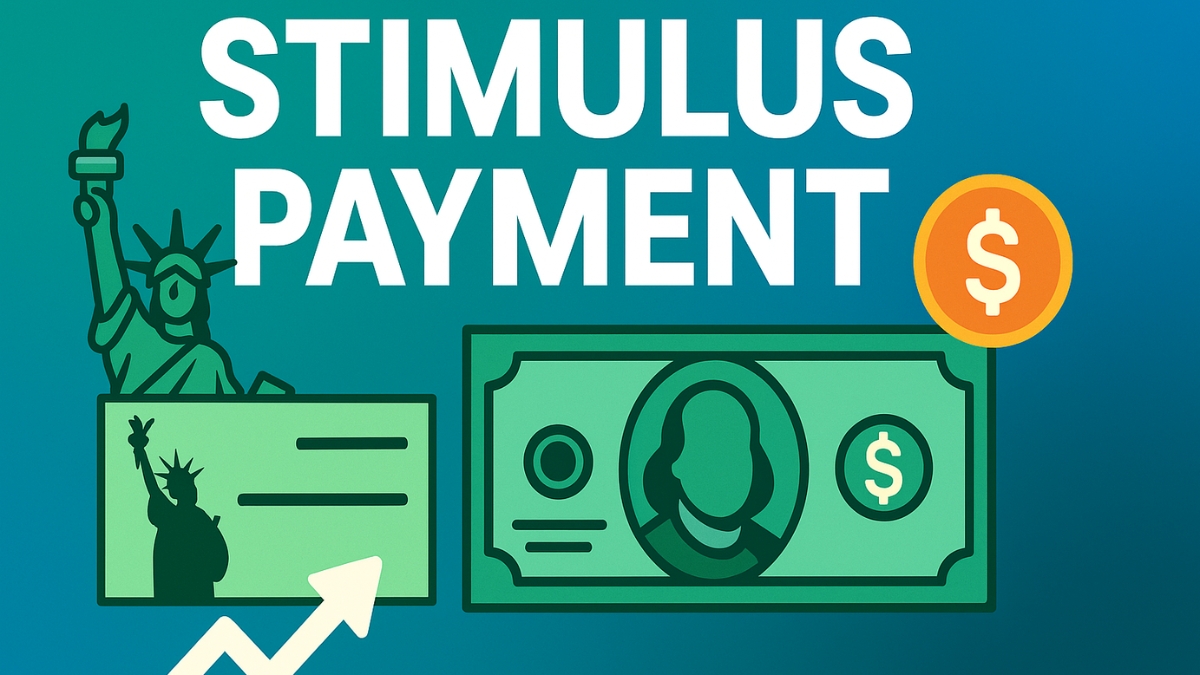In times of economic hardship, governments often provide stimulus payments to help citizens manage financial challenges and stimulate economic activity. These payments, also known as Economic Impact Payments, became widely recognized during the COVID-19 pandemic when the U.S. government issued multiple rounds of direct financial relief. As we navigate 2025, many Americans are curious about whether new stimulus payments are on the horizon or if they can still claim past payments.
This article provides a detailed overview of stimulus payments, their history, the current landscape in 2025, and actionable steps to claim unclaimed funds or benefit from state-level relief programs. Whether you’re seeking clarity on stimulus check eligibility or exploring state-specific opportunities, this guide is designed to be your go-to resource.
Table of Contents
What is a Stimulus Payment?
A stimulus payment is a direct payment from the government to individuals or families, intended to provide immediate financial relief and encourage spending to boost the economy. These payments are typically issued during economic downturns, such as recessions, natural disasters, or public health crises like the COVID-19 pandemic.
Stimulus payments can be delivered via checks, direct deposits, or debit cards, with amounts varying based on factors like income, filing status, and dependents. They are often referred to as Economic Impact Payments in official contexts, particularly by the Internal Revenue Service (IRS).
Key Features of Stimulus Payments
- Purpose: To provide financial support and stimulate economic activity.
- Eligibility: Based on income thresholds, tax filing status, and other criteria.
- Delivery: Typically via direct deposit, paper check, or debit card.
History of Stimulus Payments
The U.S. government has issued stimulus payments during various economic crises, but the COVID-19 pandemic brought them into sharp focus. Below is a summary of the three major rounds of federal stimulus payments issued between 2020 and 2021:
1. CARES Act (March 2020)
The Coronavirus Aid, Relief, and Economic Security (CARES) Act provided:
- Up to $1,200 per adult for eligible individuals.
- $500 per qualifying child under age 17.
- Payments phased out for individuals with an adjusted gross income (AGI) above $75,000 (or $150,000 for married couples filing jointly).
- A family of four could receive up to $3,400 in direct relief.
2. COVID-related Tax Relief Act (December 2020)
This act authorized:
- Up to $600 per adult and $600 per qualifying child under age 17.
- The same AGI thresholds as the CARES Act applied.
- These payments provided additional support during the ongoing pandemic.
Read More: – Stimulus Payments in 2025: A Comprehensive Guide
3. American Rescue Plan Act (March 2021)
The third round offered:
- Up to $1,400 per eligible individual, including dependents of any age.
- $2,800 for married couples filing jointly, plus $1,400 per dependent.
- Phase-outs began at $75,000 for individuals and $150,000 for joint filers.
- Additional “plus-up” payments were issued based on updated tax information.
These payments were critical in helping millions of Americans navigate job losses, business closures, and other financial challenges during the pandemic. For more details, visit the U.S. Department of the Treasury.
Stimulus Payments in 2025
As of July 2025, no new federal stimulus payments are planned. The payments issued during the COVID-19 pandemic were specific to that crisis, and no similar federal initiatives have been announced for 2025. However, there are still opportunities to claim unclaimed payments from 2021 through the Recovery Rebate Credit.
Recovery Rebate Credit in 2025
The Recovery Rebate Credit is a refundable tax credit for individuals who did not receive one or more Economic Impact Payments or received less than the full amount. In December 2024, the IRS began distributing approximately $2.4 billion in payments to about one million taxpayers who were eligible for the 2021 credit but did not claim it on their 2021 tax returns. These payments were sent automatically, with most recipients receiving them by late January 2025 via direct deposit or paper check.
For those who have not yet filed a 2021 tax return, there is still time to claim the Recovery Rebate Credit. The deadline to file a 2021 tax return and claim this credit is April 15, 2025. Even individuals with little or no income in 2021 may be eligible and should consider filing to claim their payment. For more information, visit the IRS Economic Impact Payments page.
Speculation on Future Federal Payments
There has been speculation about a potential $5,000 stimulus check tied to the Department of Government Efficiency (DOGE), an initiative led by President Donald Trump and Elon Musk to reduce federal spending. However, this proposal remains unconfirmed and unlikely, as current savings estimates suggest insufficient funds for such a program. It’s best to rely on official sources like the IRS Newsroom for updates on any future federal relief.

State-Level Stimulus and Rebate Programs in 2025
While federal stimulus payments are not currently available, several states have implemented their own relief programs to address economic challenges like inflation and high living costs. Below is a detailed overview of state-level programs in 2025, based on the latest available information:
| State | Program Name | Payment Amount | Eligibility Criteria | Deadline/Notes |
|---|---|---|---|---|
| California | Sacramento Family First | $725 monthly | 200 low-income families | Payments until November 2025, pilot program |
| California | Middle Class Tax Refunds (MCTR) | $200–$1,050 | Concluded, benefited 32 million taxpayers | Urged to activate MCTR debit cards, millions unspent |
| Colorado | TABOR Refunds | $177–$1,130 per taxpayer | Filed Colorado income tax return or PTC rebate, based on income and filing status | 2026 payments projected $41–$137 |
| Georgia | Tax Rebates | $250–$500 | Filed 2023 and 2024 returns, $250 single, $375 head of household, $500 married couples | Part of $11 billion surplus |
| Michigan | Working Families Tax Credit | Average $836, up to $550 | 700,000+ families, must meet federal EITC, file federal and state returns | Streamlined for 2025 tax filing |
| New Jersey | ANCHOR Program | Up to $6,500 combined | Combined with Senior Freeze and StayNJ, applications start March 2025 | Payments from July 2025 |
| New York | School Tax Relief Program (STAR) | $290 (Basic), $650 (E-STAR) | Homeowners, different eligibility for Basic and Enhanced STAR | Tax exemption or credit form |
| New York | Inflation Relief Checks | $300–$500 | Individuals <$150,000, families <$300,000, pending April 2025 budget approval | Excludes undocumented taxpayers |
| New York | Emergency Financial Relief Program | $500 | Families claiming Empire State Child Credit or EITC on 2023 state tax returns | Payments start May 2025, no application needed |
| Pennsylvania | Property Tax/Rent Rebate | Up to $1,200 | Age 65+, widow(er) 50+, disabled 18+, income limit $45,000 | Applications for 2023 due by December 31, 2024, extended if funds available |
| Virginia | Tax Rebate | Up to $200 single, $400 married | Filed 2024 returns by November 3, 2025, cannot exceed tax liability | Continues practice of returning surplus funds |
| Arizona | Cost of Living Assistance Fund | Up to $750 | Low-income households, application required | Applications due by May 31, 2025 |
For the latest details, check your state’s official tax authority or government website, such as California’s Franchise Tax Board or New York’s Tax Department.
How to Check if You Are Eligible for Unclaimed Stimulus Payments
If you believe you missed the third Economic Impact Payment from 2021, you can claim it through the Recovery Rebate Credit. Here’s how:
- Determine Eligibility:
- Eligible if your 2021 AGI was below $75,000 (single) or $150,000 (married filing jointly).
- Payment amount: $1,400 per person, including dependents.
- Verify Payments Received:
- Log into your IRS online account to view payment history.
- Check IRS notices like Letter 6475, which confirms the third payment amount.
- File a 2021 Tax Return:
- File by April 15, 2025, to claim the credit, even if you had minimal or no income.
- Use the Recovery Rebate Credit worksheet in the tax return instructions.
- Gather Information:
- Confirm the total Economic Impact Payments received using your IRS account or notices.
- Ensure you have a valid Social Security number and are not claimed as a dependent.
- Submit Your Return:
- File electronically or by mail through the IRS or a reputable tax professional.
- Double-check calculations to avoid delays.
Also Read: – Understanding the United States Space Force: A Comprehensive Guide
If you already filed your 2021 return but didn’t claim the credit, the IRS may have sent an automatic payment based on their records. For assistance, visit the IRS Recovery Rebate Credit page.
Frequently Asked Questions (FAQs)
1. What is the difference between a stimulus payment and the Recovery Rebate Credit?
A stimulus payment is a direct payment from the government to eligible individuals, also known as an Economic Impact Payment. The Recovery Rebate Credit is a tax credit that allows taxpayers to claim missed or partial stimulus payments on their tax return. For example, if you were eligible for the 2021 payment of $1,400 but didn’t receive it, you can claim the credit when filing your 2021 tax return. The credit is refundable, meaning you can receive it even if you owe no taxes. To claim it, ensure you file by April 15, 2025, and include accurate payment information from your IRS account or Letter 6475.
2. Can I still claim the 2021 Recovery Rebate Credit in 2025?
Yes, you can claim the 2021 Recovery Rebate Credit by filing a 2021 tax return by April 15, 2025. This applies even if you had little or no income in 2021. The IRS encourages non-filers to submit a return to claim the credit, which could provide up to $1,400 per person, including dependents. Check your eligibility using the IRS online account and ensure you have all necessary documentation, such as Letter 6475, to avoid errors.
3. How do I know if I received all my stimulus payments?
To confirm whether you received all your stimulus payments, log into your IRS online account and check the Tax Records section for payment history. Alternatively, review IRS notices like Notice 1444-C or Letter 6475, which detail the amounts received for the third payment. If you find discrepancies, you may be eligible to claim the Recovery Rebate Credit on your 2021 tax return. Contact the IRS or a tax professional if you need assistance.
4. Are there any state stimulus payments in 2025?
Yes, several states are offering state stimulus payments or rebates in 2025 to address economic challenges like inflation. For example, California’s Sacramento Family First program provides $725 monthly to low-income families, while New York’s Inflation Relief Checks offer $300–$500 to eligible residents. Other states like Georgia, Michigan, and Virginia have their own programs with varying eligibility criteria. Check your state’s official website, such as New Jersey’s ANCHOR Program, for specific details and application processes.
5. What should I do if I didn’t receive my state stimulus payment?
If you believe you’re eligible for a state stimulus payment but haven’t received it, contact your state’s tax authority or relevant government agency. For example, in California, reach out to the Franchise Tax Board. Provide your tax filing details and any relevant documentation, such as confirmation of eligibility or application submission. Avoid third-party websites claiming to process payments, as they may be scams. Always work directly with official state or IRS resources.
6. Is there a possibility of new federal stimulus payments in the future?
As of July 2025, no new federal stimulus payments are confirmed. Speculation about a $5,000 DOGE dividend has surfaced, but it remains unverified and unlikely due to funding constraints. Economic conditions can change, so it’s wise to stay informed through trusted sources like the IRS Newsroom or U.S. Treasury. If new relief programs are announced, eligibility and application details will be shared through these channels.
Conclusion
While no new federal stimulus payments are scheduled for 2025, opportunities remain to claim unclaimed 2021 payments through the Recovery Rebate Credit by filing a 2021 tax return by April 15, 2025. Additionally, states like California, New York, and Georgia are offering their own relief programs to support residents facing economic pressures. By checking your eligibility and staying informed, you can ensure you receive the financial support you’re entitled to.
We encourage you to share this guide with others who might benefit and subscribe to our newsletter for the latest updates on stimulus payments and tax-related news. Have questions or experiences to share? Leave a comment below!










